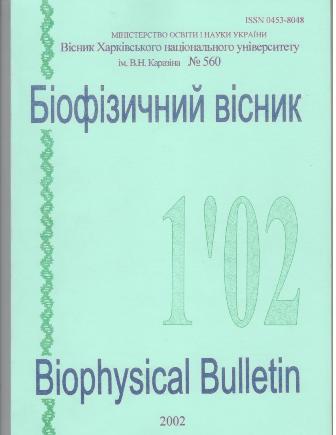Physical mechanisms of interaction of actinocin derivatives with DNA. 6. Spectrophotometric analysis of DNA-actinocin complexes for actinocin derivatives with different length of methylene chaines
Abstract
Complexation of actinomycin derivatives with calf thymus DNA has been studied as a function of the number of methyl groups (n= 2 - 5) in the side chains by UV-visible spectroscopy. It has been shown that two types of complexes are being formed in DNA-antibiotic solution and the number of the binding sites in the first type of complex formation increases with an increase of both n and ionic strength of the solution. Binding isotherms in solutions containing 2.10-2 M NaCl and 0.16 M NaCI have been determined for all the ligands studied in the mixture with DNA. The number of the binding sites and the equilibrium constants of the formation of the first type of complexes have been obtained from the analysis of the binding isotherms. Using the program of optimization of spectrophotometric concentration dependences DALSMOD, binding constants of formation of the first and second types of complexes have been calculated and the number of binding sites for the second type of complexes has been determined, which comprise the solutions of calf thymus DNA and the considered ligands 5-6 or 7-8 base pairs for two above-cited ionic strengths, respectively. Dimerization of the investigated antibiotics was taken into account in the analysis of the binding isotherms and in the calculation of the complexation parameters. It is found that the melting temperature (Tm) of DNA in the mixture with actinocin derivatives increases with decreasing of the length of the side chains in the phenoxazone chromophore.
Downloads
References
2. Wemmer D.F., Dervan P.B.//Сиrr.Орin.Struct.Biol. 1997. V.7. Р.355-361.
3. Chaires J.B.// Сиrr. Орin. Struct.Biol. 1998. V.8. Р.314-320.
4. Wadkins R.M., Vladu B., Tung Ch.-Sh//Вiochemistry. 1998. V.37. Р.11915-11923.
5. Karawajev L., Glibin E.M., Ma1eev Y.Ya, . Czewony G., Dorken B., Davies D.B.Veselkov A.N. //Anti-Cancer Drug Design. 2000. V. 15. P.33 1 -338.
6. Кривцова М.А., Морошкина Е.Н., Глибин Е.Н., Фрисман Э.В.//Молекуляр. биология. 1982. Т. 16. Вып.1. С.149-155.
7. Семенов М.А., Гасан А.И., Малеев В.Я. и др.//Вісн. Харк.ун-ту. №488. Біофізичний вісник. 2000. Вип.. 6(1). С. 14-18.
8. Семенов М.А., Сагайдакова Н.Н., Больбух Т.В. и др.// Вісн. Харк.ун-ту №497. Біофізичний вісник. 2000. Вип.2(7). С, 16-23.
9. Семенов М.А., Больбух Т.В., Березняк Е.Г. и др.// Вісн. Харк.ун-ту № 528 . Біофізичний вісник. 2001. Вип.2(9). С.40-44.
10. Круглова Е.Б., Малеев В.Я., Глибин Е.Н., Веселков А.Н.// Вісн. Харк.ун-ту . Біофізичний вісник 2002 (в печати).
11. Глибин Е.Н., Плеханова Н.Г., Овчинников Д.В., Коршунова З.И.//ЖОр.Х. 1996. Т.32. Вып.2. С.406-408.
12. Глибин Е.Н., Овчинников Д.В., Плеханова Н.Г.//ЖОр.Х. 1997. Т.ЗЗ. Вып.10. С. 1573-1576.
13. Muller W., Crothers D.M.// /Eur J. Biochem. 1975. V.54. P.267-277.
14. Хартли Ф., Бергес К., Олкок Р. Равновесия в растворах. М.: Мир. 1983. 360 С.
15. McGhee J.D., von Hippel P.H.// J. Mol.Biol.1974. V.86. N.3. P.469-489.
16. Нечипуренко Ю.Д.//Молекуляр.биология. 1984. Т. 18. № 4 . С. 1066-1080.
17. Круглова Е.Б. //Молекуляр.биология. 1991. Т.25. С.60-68.
18. Круглова Е.Б.//Молекуляр.биология. 1993. Т.27. С.655-665.
19. Круглова Е.Б. //Вicн. Харк.ун-ту. №525. Біофізичний вісник. 2001. Вип.1(8). С.27-33.
Authors who publish with this journal agree to the following terms:
- Authors retain copyright and grant the journal right of first publication with the work simultaneously licensed under a Creative Commons Attribution License that allows others to share the work with an acknowledgement of the work's authorship and initial publication in this journal.
- Authors are able to enter into separate, additional contractual arrangements for the non-exclusive distribution of the journal's published version of the work (e.g., post it to an institutional repository or publish it in a book), with an acknowledgement of its initial publication in this journal.
- Authors are permitted and encouraged to post their work online (e.g., in institutional repositories or on their website) prior to and during the submission process, as it can lead to productive exchanges, as well as earlier and greater citation of published work (See The Effect of Open Access).





